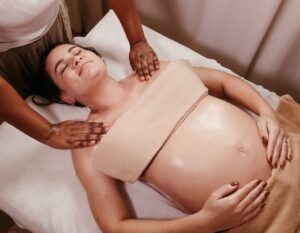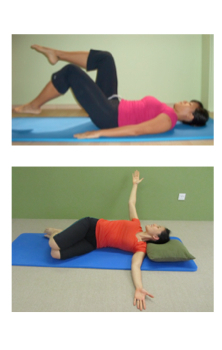
Eager to get back in the exercising groove after giving birth? Our experts have the lowdown on postnatal exercise.
Please welcome the team from Focus with the rundown on when you can start exercising after birth, and what you can be doing, mama!
When is it safe to start exercising after giving birth?
This depends on whether you delivered naturally or by c-section, but also on the type of exercise you wish to commence.
Pilates is a low impact exercise, and after a natural birth it is possible to start gentle pelvic floor exercises and pelvic tilts within days. To start back into supervised Pilates, whether private sessions or post natal Reformer classes, will take a little longer, and it’s recommended to wait six weeks following a natural birth and eight weeks following a Caesarean section.
This is of course based on your doctor’s approval and assumes there are no other complicating factors such as back pain, pubic pain or a separation of the abdominals.
For other forms of exercise such as general weight training, running or team sports, you will need to wait a minimum of 4-6 weeks before you can begin these again.
How long until I’m able to return to my full, pre-pregnancy exercise routine? There is no fixed rule for this, and it is important to remember that your body had nine months to develop to full term. During this time, many changes occurred gradually so it will also take time for things to revert back to the way they were before.
With a newborn, there are additional stresses on both your time and energy levels that also add a little (or a lot of!) extra challenge. The key is to start off gently, and based on how your body feels and with the guidance of your healthcare professional, you can gradually increase the duration and intensity of your workout. Rushing things can lead to injury, so be patient and go easy on yourself!
For higher intensity activities such as running, high impact movements or stronger abdominal exercises, you might need to wait 8-12 weeks or more before you can commence these at pre-pregnancy levels. Again, be patient with yourself!
What are some good exercises I can do to ease back into exercising?
As a guide to ease back into exercise, you will want to start with some gentle movements to activate the areas of your body that have been fixed in place (or stretched) for several months.
A range of safe and effective Pilates exercises can be carried out, including pelvic tilts, bridging, quadruped, book openings, femur arcs and dart. Slowly build up your exercise your routine, remembering to start with a lower intensity and duration that what you would have before your pregnancy.
Pelvic Tilts:
- Lie on your back with your knees bent
- Tuck you tailbone under as you flatten your spine into the mat to posteriorly tilt the pelvis.
- Allow you spine to arch away from the mat as you send the pubic bone in between the legs to anteriorly tilt the spine.
-
- Position yourself on your hands and knees.
- Arms – Maintain a stable position as you exhale and float one arm forwards towards your ear. Inhale to lower. Repeat on the other side.
- Legs – Maintain a stable position and exhale as you lift one leg behind. Inhale to lower. Repeat on the other side.
- Cross – Maintain a stable position as you exhale and float the arm and opposite leg up. Inhale to lower. Repeat on the other side.
Bridging:
- Lying on your back with your knees bent.
- Exhale to send your tailbone towards the back of your knees as you peel your back off the mat until you rest in between your shoulder blades.
- Inhale and exhale to peel down.
Are there any particular moves for strengthening my pelvic floor?
It is of course hugely beneficial to have learnt pelvic floor exercises before or during pregnancy, as learning after delivering your baby makes it tough to feel the right muscles activate. Apart from specific pelvic floor (kegel) exercises, gentle pelvic tilts, adductor squeezes and pelvic stability exercises (such as dead bug, bent knee fall out, femur arcs) are also good.
- Lying on your back with both legs in table top position.
- Exhale to dip one leg down maintaining the knee at 90 degrees and a stable (neutral) pelvis then inhale and lift back up to table top.
- Repeat on the opposite side.
Book Openings:
- Lie on your side with knees bent, feet in line with your hips and hands clasped behind your head.
- Open your top elbow towards the ceiling, then roll your head to follow and open your chest towards the ceiling.
- Maintain the abdominals drawing in and connecting the ribs to the pelvis.
Bent Knee Fallout:
- Lying on your back with both legs bent.
- Exhale and slowly let one knee fallout to the side.
- Using abdominal contractions try and maintain your pelvis in a horizontal position.
- Inhale to draw back to midline.
Dead Bugs:
- Lying on your back with your knees bent.
- Keeping the knee and hip at 90 degrees inhale and float the leg to a table top position maintain a stable pelvis then exhale to lower.
- Repeat on the other side.
Are there any risks or physical warning signs I should watch out for?
Always base your exercise on how you feel on the day. If you don’t feel 100% then scale down the intensity or duration of your exercise. If you are experiencing any back pain, pelvic pain, abdominal pain, reduced bladder or bowel control, or if you experienced any difficulties during your pregnancy or birth, these should be discussed with your doctor or physiotherapist prior to commencing exercise. They can then give you the best guided advice on what is safe for you.
Top Five Tips for Exercising after Birth:
- Check with your Doctor prior to commencing any post natal exercise.
- Listen to your body, and gently ease back into exercise.
- Take your rest days!
- Mix in a strength and conditioning exercise like Pilates with gentle cardio such as walking or swimming.
- Aim to slowly build up your strength and stamina, and know that it’s ok for this to take a few months.
 View All
View All


 View All
View All

 View All
View All
 View All
View All
 View All
View All


 View All
View All










![[𝗛𝗢𝗧 𝗡𝗘𝗪𝗦] 𝗦𝗲𝗻𝗴𝗸𝗮𝗻𝗴 𝗦𝘄𝗶𝗺𝗺𝗶𝗻𝗴 𝗖𝗼𝗺𝗽𝗹𝗲𝘅 𝗶𝘀 𝗕𝗔𝗖𝗞 𝘄𝗶𝘁𝗵 𝗡𝗘𝗪 𝗦𝗟𝗜𝗗𝗘𝗦 & 𝗙𝗘𝗔𝗧𝗨𝗥𝗘𝗦! 💦🔥
One of the most popular pools in the North-East is finally back and it’s even better than before! Brand-new slides for thrill-seekers (1.2m+), splash zones for little ones, a Jacuzzi, sheltered teaching pool, and an Olympic-sized pool for serious swimmers.
Say goodbye to the rainbow slides as the new ones are faster, wider & way more fun! Just remember: proper swimwear only, and no accessories for max sliding speed.
𝗪𝗵𝗲𝗿𝗲: 57 Anchorvale Rd, Singapore 544964 (5 mins from Sengkang LRT)
𝗪𝗵𝗲𝗻: Tues/Thurs/Sat: 6.30am – 9.30pm | Wed/Fri/Sun: 8am – 9.30pm | Mon: Closed
𝗛𝗼𝘄 𝗺𝘂𝗰𝗵: Family of 4 (weekend) = Just $7!
Tag your splash squad & get ready for a wave of fun! 🏄♂️
.
.
.
.
.
.
.
#SengkangSwimmingComplex #SGPools #FamilyFunSG #WaterPlaySG #NorthEastLiving #SengkangReopens #KidsActivitiesSG #SengkangFun #publicswimmingpool](https://www.sassymamasg.com/wp-content/plugins/instagram-feed/img/placeholder.png)
